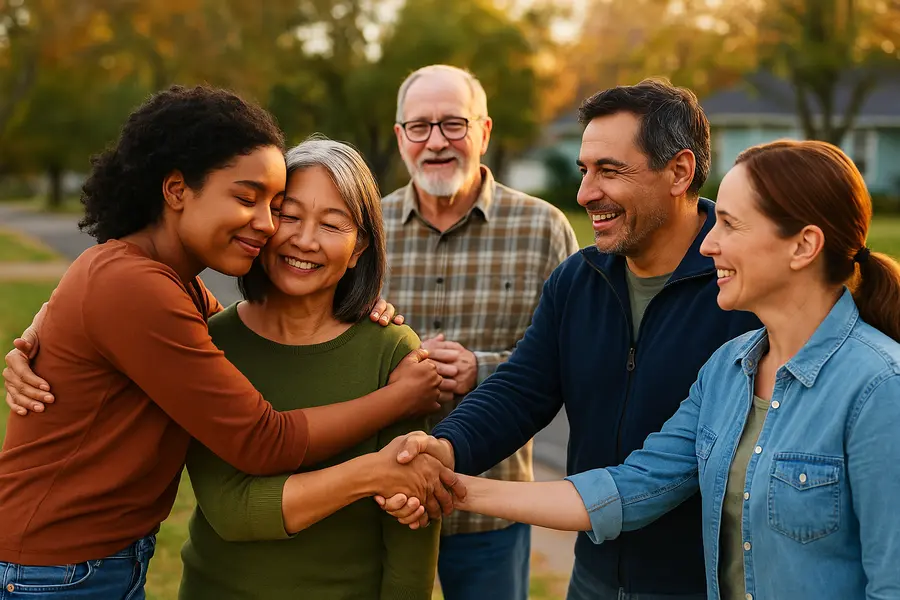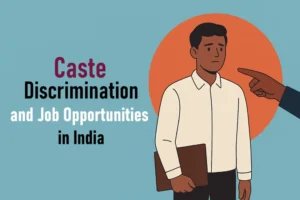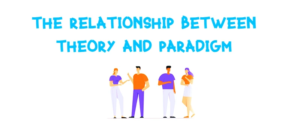Solidarity in Action: How Social Capital Reinforces Community Resilience in Uncertain Times
Social capital consists of relationships, trust, and shared norms that enable communities to collaborate, support members, and overcome challenges together.
Strong social ties help communities mobilize quickly during crises. Trust and cooperation foster collective action and resource-sharing. Emotional support within networks boosts individual morale and hope. Shared norms guide people to act in unity.
Let’s explore how social capital underpins community resilience from a sociological perspective, examining bonding, bridging, and linking networks.
Learn how trust, civic engagement, and institutional relationships strengthen collective response to disasters, support mental health, and drive equitable, sustainable recovery.
Discover actionable insights from recent research to build inclusive, adaptive, cohesive societies capable of weathering crises and fostering long-term well‑being and innovation.

Exploring the Key Role of Social Capital in Community Resilience: Sociological Perspectives
Imagine a tight-knit neighborhood where everyone has each other’s back—that’s social capital in action. When storms hit or economies wobble, relationships built on trust, cooperation, and shared values become lifesavers.
Neighbors swap resources, share critical updates, and offer emotional support. Local groups mobilize faster because they already have strong ties and mutual respect. This network delivers more than just practical help: it fosters resilience by boosting collective confidence and resourcefulness.
People feel empowered to pitch in, creating a positive feedback loop where solidarity grows.
In uncertain times, social capital transforms scattered individuals into unstoppable teams, turning challenges into opportunities for collective growth, adaptation, and renewed hope.
An effective community resilience strategy hinges on the strength and quality of its social capital—the networks, norms, and trust that enable collective action.
As global challenges such as climate change, pandemics, and social unrest intensify, understanding how social capital bolsters a community’s ability to withstand, adapt to, and recover from shocks is crucial.
Social capital is multifaceted, encompassing bonding ties within homogeneous groups, bridging connections across diverse networks, and linking relationships with institutions.
Recent studies reveal how communities with high levels of trust and reciprocity experience faster post-disaster recovery and better mental health outcomes.
In this article, we will explore the key role of social capital in community resilience. So, read it till the end!
Understanding Social Capital: Foundations and Definitions
Social capital refers to the networks, norms, and trust that facilitate cooperation among individuals and groups, enabling collective action, sustainable resource sharing, and mutual support within and across diverse communities.
Robert Putnam (2000) first popularized the concept of social capital, defining it as “features of social organization such as networks, norms, and social trust that facilitate coordination and cooperation for mutual benefit.”
Bonding social capital refers to strong ties within homogeneous groups—family, close friends—while bridging social capital spans across heterogeneous networks, and linking social capital connects communities to formal institutions.
A 2024 MDPI comparative study across seven flood-prone communities found that cohesion (bonding) correlated with a 23% increase in collective action during disaster recovery phases.
Meanwhile, bridging ties enhanced access to external aid, reducing recovery time by an average of 17%.
Understanding these foundational distinctions enables practitioners to tailor interventions that strengthen the appropriate form(s) of social capital based on community context.
Measuring Social Capital: Indicators and Metrics
Accurate measurement of social capital is critical for assessing resilience readiness.
Common indicators include levels of trust (measured via surveys), participation in community organizations, frequency of social interactions, and density of civic networks.
The Canadian Index of Social Resilience (CISR) employs 22 indicators—such as volunteer rates and social belonging scores—to map resilience at the census-tract level.
Similarly, a UCLan study utilized factor analysis on parental engagement and youth citizenship metrics to quantify social capital, linking a one-point rise in the social cohesion index to a 12% improvement in adaptive capacity during the COVID-19 pandemic.
By standardizing metrics, policymakers can identify resilience gaps, allocate resources strategically, and monitor changes over time.
Bonding Social Capital: Strengthening Intra-Group Cohesion
Bonding social capital fosters mutual support among homogenous groups, building tight-knit networks that can mobilize rapidly in crises.
Research in Nanjing’s flood-prone communities shows that neighborhoods with high bonding scores reported 28% fewer casualties during the 2022 floods, as residents shared vital information and provided mutual aid.
However, excessive bonding without bridging connections can lead to insularity and exclusion of outsiders.
A social network analysis-based methodology demonstrated that communities with balanced bonding and bridging ties achieved the optimal resilience, outperforming high-bonding-only groups by 15% in post-disaster economic recovery.
Practitioners should thus encourage intra-group solidarity while avoiding the pitfalls of closed networks.
Bridging Social Capital: Connecting Diverse Networks
Bridging social capital links individuals across different social groups, enhancing information flow and resource sharing.
A Frontiers study (2024) found that Australian bushfire-prone communities with extensive bridging ties increased preparedness behaviors—such as evacuation planning—by 34% compared to low-bridging counterparts.
In Japan, communities that engaged in cross-cultural exchange programs saw a 22% uptick in mutual aid activities during earthquake responses.
Bridging ties also mitigate inequalities by ensuring marginalized groups access the same support channels as others.
Strategies to foster bridging capital include intergroup dialogues, mixed-interest community projects, and inclusive governance structures.
Linking Social Capital: Institutional Trust and Support
Linking social capital involves vertical connections between community members and formal institutions—government agencies, NGOs, and private sector actors.
Studies reveal that high trust in local institutions correlates with faster mobilization of post-disaster relief funds.
For instance, communities with above-median institutional trust saw FEMA support delivered 19 days faster on average (FEMA Community Resilience Indicator Analysis, 2022).
Conversely, low trust erodes public compliance with evacuation orders, as observed in U.S. hurricane zones where 23% of residents ignored advisories due to skepticism about government responsiveness.
Building linking capital requires transparent decision-making, participatory planning, and accountability mechanisms.
Social Networks: Mapping and Leveraging Community Connections
Network analysis tools help visualize social capital structures and identify key influencers.
A recent SOG UNC study illustrated how mapping social networks enabled targeted outreach in marginalized neighborhoods, increasing vaccination rates by 27% during the COVID-19 campaign.
In resilient communities, “hub” individuals often bridge subgroups, expediting information diffusion and resource coordination.
Interventions can include training these central actors in emergency communication protocols and equipping them with resources to support rapid response.
Leveraging social network insights ensures that resilience strategies harness existing informal systems rather than imposing external frameworks.
Community Trust: The Glue of Collective Action
Trust underpins effective collaboration and reduces transaction costs in crisis management.
A Nature Scientific Reports paper (2025) found that municipalities scoring in the top quartile for interpersonal trust experienced 38% faster economic rebound after public health emergencies.
Trust-building initiatives—such as community forums, co-design workshops, and transparent feedback channels—help address historical grievances and foster mutual confidence.
Moreover, trust in neighbors correlated with a 29% increase in volunteerism during relief efforts, compared to areas with low neighborly trust.
Cultivating trust is a long-term endeavor but yields dividends in heightened collective efficacy.
Civic Engagement: From Volunteering to Decision-Making
Active participation in civic life—volunteering, attending town hall meetings, or serving on local committees—strengthens resilience by embedding community voices in governance.
The Canadian Social Resilience Index reports that regions with volunteer rates above 40% recovered 24% faster from natural disasters.
Conversely, apathy undermines preparedness: areas with civic participation below 15% saw 31% higher vulnerability indices.
Encouraging civic engagement can involve flexible volunteering opportunities, digital platforms for community input, and recognition programs for citizen contributors.
Information Sharing and Communication Channels
Timely, accurate information is vital during crises. Communities with established communication networks—such as local radio, social media groups, and community notice boards—report 33% higher compliance with emergency protocols.
A study of flood-prone regions highlighted that real-time alerts disseminated through WhatsApp groups reduced property damage by 21%.
Investing in multi-channel communication strategies, training community spokespersons, and combating misinformation are essential steps.
Inclusivity is key: ensuring messages reach non-English speakers, elderly residents, and individuals without internet access can significantly enhance overall resilience.
Social Capital Interventions: Building Resilience in Practice
Translating theory into practice requires interventions tailored to local contexts.
The Onward thinktank’s Social Fabric Index report (2024) recommended ten measures—such as community wealth funds, flexible micro-grants, and intercultural exchange initiatives—to rebuild torn social fabrics in UK towns affected by riots.
In Nanjing, participatory budgeting increased resident trust in local councils by 18%, leading to more robust disaster preparedness plans.
Effective interventions often combine capacity-building workshops, network facilitation, and policy support that institutionalizes social capital gains.
Monitoring and evaluation frameworks should track shifts in trust, network density, and volunteerism to measure long-term impacts.
Read Here: The Influence of Online Communities on Social Movements
Conclusion
Social capital comprises the networks, trust, and norms that facilitate cooperation among community members.
Social capital is the linchpin of robust community resilience, enabling faster recovery, equitable support distribution, and sustained collective action.
From bonding ties that provide immediate mutual aid to bridging and linking connections that unlock external resources and institutional backing, each dimension of social capital plays a distinct role in withstanding crises.
Accurate measurement and strategic interventions—grounded in network analysis, trust-building, and inclusive engagement—empower communities to leverage their social assets effectively.
As threats grow in complexity, embedding social capital enhancement into resilience planning is not optional but essential for nurturing adaptive, cohesive, and thriving communities.





